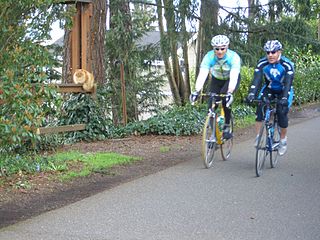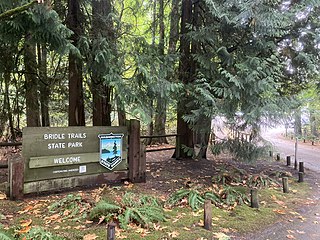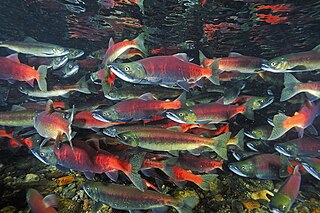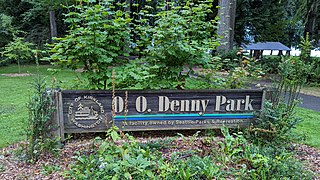
Redmond is a city in King County, Washington, United States, located 15 miles (24 km) east of Seattle. The population was 73,256 at the 2020 census.

Kenmore is a city in King County, Washington, United States, along the northernmost shore of Lake Washington. It is a suburban commuter town at the mouth of the Sammamish River, 12 miles (19 km) northeast of downtown Seattle and 2 miles (3.2 km) west of Bothell. The population was 23,914 at the 2020 census. Kenmore Air Harbor is the largest seaplane-only passenger facility of its kind in the United States.

Sammamish is a city in King County, Washington, United States. The population was 67,455 at the 2020 census. Located on a plateau, the city is bordered by Lake Sammamish to the west and the Snoqualmie Valley to the east. Sammamish is situated 20 miles east of Seattle, is a member of the Eastside, and is a part of the Seattle metropolitan area. Incorporated in 1999, Sammamish is an affluent community and has been ranked as one of the wealthiest cities in Washington.

Bothell is a city in King and Snohomish counties in the U.S. state of Washington. It is part of the Seattle metropolitan area, situated near the northeast end of Lake Washington in the Eastside region. It had a population of 48,161 residents as of the 2020 census.

Lake Washington is a large freshwater lake adjacent to the city of Seattle, Washington, United States. It is the largest lake in King County and the second largest natural lake in the state of Washington, after Lake Chelan. It borders the cities of Seattle on the west, Bellevue and Kirkland on the east, Renton on the south, and Kenmore on the north, and encloses Mercer Island. The lake is fed by the Sammamish River at its north end and the Cedar River at its south.

Lake Sammamish is a freshwater lake 8 miles (13 km) east of Seattle in King County, Washington, United States. The lake is 7 miles (11 km) long and 1.5 miles (2 km) wide, with a maximum depth of 105 feet (32 m) and a surface area of 8 sq mi (21 km2). It lies east of Lake Washington and west of the Sammamish Plateau, and stretches from Issaquah in the south to Redmond in the north. At Issaquah it is fed by Issaquah Creek, and at Redmond it drains to Lake Washington via the Sammamish River, named after the native people who once lived along its entire length.

The Sammamish River flows through north King County, Washington for about 14 miles (23 km), draining Lake Sammamish into Lake Washington. Along its course, the Sammamish River flows through Redmond, Woodinville, Bothell, and Kenmore.

The Burke–Gilman Trail is a rail trail in King County, Washington. The 20-mile (32 km) multi-use recreational trail is part of the King County Regional Trail System and occupies an abandoned Seattle, Lake Shore and Eastern Railway (SLS&E) corridor.

Kisatchie National Forest, the only National forest in Louisiana, United States, is located in the forested piney hills and hardwood bottoms of seven central and northern parishes. It is part of the Cenozoic uplands and has large areas of longleaf pine forests. It is one of the largest pieces of natural landscape in Louisiana, with some 604,000 acres (2,440 km2) of public land, more than half of which is vital longleaf pine and flatwoods vegetation. These support many rare plant and animal species. There are also rare habitats, such as hillside seepage bogs and calcareous prairies. The forest also contains and provides a buffer for the Kisatchie Hills Wilderness, a nationally designated wilderness area that contributes to protecting biodiversity of the coastal plain region of the United States.

Bridle Trails State Park is a 489-acre (198 ha) state park in the Bridle Trails neighborhood in an unincorporated part of the Eastside area of King County, Washington. Established in 1932 and developed in 1933 by the Civil Works Administration, primary features of the park include a forested trail system shared by pedestrians and equestrians and an outdoor arena used for equestrian purposes.

The East Lake Sammamish Trail is an 11-mile (18 km) recreational rail trail in King County, Washington that runs along Lake Sammamish from Marymoor Park in Redmond, through Sammamish, to Gilman Boulevard in Issaquah.

The Colville National Forest is a U.S. National Forest located in northeastern Washington state. It is bordered on the west by the Okanogan–Wenatchee National Forest and the Kaniksu National Forest to the east. The forest also borders Little Pend Oreille National Wildlife Refuge and the Lake Roosevelt National Recreation Area.
Klahanie is a planned community in Sammamish, Washington, United States. The population was 10,674 at the 2010 census. Prior to its annexation by the city of Sammamish in 2016, Klahanie was a census-designated place (CDP) in unincorporated King County.

Lake Sammamish State Park is a park at the south end of Lake Sammamish, in King County, Washington, United States. The park, which is administered by the Washington State Park System, covers an area of 512 acres (0.80 sq mi) and has 6,858 feet (2,090 m) of waterfront; Issaquah Creek meets with Lake Sammamish within the park. It is a popular location for boating and watersport activities, such as waterskiing.

The Turnbull National Wildlife Refuge is located six miles (10 km) south of Cheney, Washington, on the eastern edge of the Columbia Basin in Spokane County in northeastern Washington. Turnbull NWR encompasses more than 23,000 acres (9,300 ha) of the Channeled Scablands. The ecosystem that predominates the refuge is unique within the National Wildlife Refuge System and has characteristics that distinguish it from natural reserves worldwide. The combination of basalt outcrops, channeled canyons, and ponderosa pine forests infused in a diverse landscape of over 130 marshes, wetlands, and lakes creates an environment of aesthetic beauty as well as high quality wildlife habitat. The refuge is named for Cyrus Turnbull who lived on the site in the 1880s.

G. Richard Thompson Wildlife Management Area, one of the richest botanical areas of Virginia's Blue Ridge Mountains, is a 4,000-acre (16 km2) Wildlife Management Area (WMA) located primarily in Fauquier County, Virginia, with small encroachments into both Warren and Clarke counties.

Marymoor Park, located on the north end of Lake Sammamish in Redmond, Washington, is King County's largest, oldest, and most popular park, with more than 3 million annual visitors coming to roam its 640 acres (2.6 km2). Among recreational activities available are various sports facilities, rock climbing, a 40-acre off-leash dog park and a velodrome. It is also one end of the Sammamish River Trail, a biking and walking trail. In addition, a radio control aircraft flying field and a pet memorial garden are within the park's boundaries.

Glacial erratic boulders of King County are large glacial erratic boulders of rock which were moved into King County, Washington by glacial action during previous ice ages.

The kokanee salmon, also known as the kokanee trout, little redfish, silver trout, kikanning, Kennerly's salmon, Kennerly's trout, or Walla, is the non-anadromous form of the sockeye salmon. There is some debate as to whether the kokanee and its sea-going relative are separate species; geographic isolation, failure to interbreed, and genetic distinction point toward a recent divergence in the history of the two groups. The divergence most likely occurred around 15,000 years ago when a large ice melt created a series of freshwater lakes and rivers across the northern part of North America. While some members of the salmon and trout family (salmonids) went out to sea (anadromous), others stayed behind in fresh water (non-anadromous). The separation of the sockeye and the kokanee created a unique example of sympatric speciation that is relatively new in evolutionary terms. While they occupy the same areas and habitats during the breeding season, when ocean-going sockeye salmon return to freshwater to spawn, the two populations do not mate with each other in some regions, suggesting speciation.

O.O. Denny Park is a 46-acre (19 ha) park on the northeast shore of Lake Washington that is managed by the city of Kirkland, Washington but is owned by the city of Seattle. It has approximately 0.25 miles (400 m) of Lake Washington shoreline, and some park amenities such as BBQ grills and a covered structure at the shore, with mostly unimproved forest above the lake, surrounding Denny Creek.




















